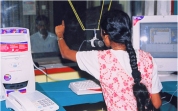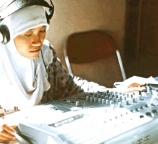








|

UNESCO Photo
|
|
|
 |
|
Knowledge
in the Village: Mixing and Matching Technologies for Connectivity
Rohan
Samarajiva1
Keynote address
Kuala Lampur, September 4, 1999.
View slides
Escaping poverty requires knowledge: Knowledge of how to do
things (know-how as in how to get more milk from a cow) as well as knowledge of attributes
(e.g., how likely am I to get my money back if I lend this person money). The World
Bank’s latest World Development Report2 explicitly and eloquently states what has been known in an
amorphous way for a long time. Knowledge matters.
In today’s fast
changing global environment, traditional forms of knowledge acquisition fall short. Adults
as well as children need access to mechanisms that foster creativity and access to
multiple sources of "facts" that can no longer be learned for life. Many think
the Internet and associated technologies are such a mechanism. But, knowledge by itself,
or the Internet by itself, is no panacea. Knowledge is a necessary, but not sufficient,
condition for the betterment of the human condition.3 Access to
the Internet, in today’s world, is a necessary but not sufficient condition for
knowledge work.
The United States frets over the uneven terms of access to
the Internet by its citizens.4 But disparities of access within the US are nothing compared to
those in developing countries. The numbers are not precise and they keep changing, but the
evidence is clear: an overwhelming majority of people living in developing countries,
especially those living in rural areas, are not connected to any form of electronic
network, except the one-way medium of radio broadcasting. Unless conventional thinking is
abandoned, these people will not have interactive connectivity in their lifetimes. And
without that connectivity, they and their children will have difficulty in becoming
knowledgeable. Without knowledge, they will continue to be poor and are likely to be
disaffected. And large numbers of disaffected people are not conducive to stable
prosperous societies.

Sri Lanka, which is generally considered to be a success
story of institutional reform in telecommunications,5 provides a
good illustration of the problems (and possibly of the solutions). It was estimated that
by the end of the First Quarter of 1999, there were around 38,000 persons with access to
the Internet in this country with a population of over 18 million and a per capita GNP of
around US$ 800. There were 250 registered servers.6 There are a
number of barriers to Internet access in Sri Lanka:
- With a teledensity of 2.8 at the end of 1998, there are only
a few households that are in a position to get Internet access. This is despite
extraordinary annual growth rates of 40-50% in recent years driven by head-to-head
competition.
- The network is highly congested, partly because of bad
design and dimensioning and partly because of the rapid growth rates. The problem is
particularly acute for users outside Colombo.
- Metered billing causes additional costs to Internet users
who tend to stay online for long periods. The recently created "Internet
chargeband" from 10 PM to 5 AM alleviates the problem to some extent.
- ISP [Internet Service Provider] charges are relatively high.
This may be caused by possible anti-competitive practices in the supply of leased lines.
Some feel that the license fees of US$ 4,000 (one-time) and 0.3% of turnover annually may
also be contributing to the problem. But the Telecommunications Regulatory Commission
(TRC) has stated that it will not limit the number of ISPs (more than 10 so far) which
should control prices. The Ministry of Posts, Telecommunications & the Media has
allowed all licensed ISPs direct access to satellites which should ease their congestion
problems and also help bring down costs. The Commission has initiated a public hearing on
Internet access and quality that should help identify the appropriate solutions.
Rural access is affected by additional problems:
- Even after over 100 years as a "public service"
monopoly, the major supplier still has a majority of its lines in metro Colombo. At end
1998, metro Colombo had 240,067 lines against the 215,531 in the rest of the country.
- The competitive fixed-access providers licensed in 1996 are
only beginning to enter the rural market. Currently they have over 70,000 lines
concentrated in the densely populated Western seaboard.
- Leased lines are easier to obtain in Colombo. For the line
for the Kotmale project (about 150 km from Colombo), the Commission spent over $ 7,500 in
the first year. If not for the high-level of government commitment to the project, such a
line may not have been provided by the major supplier.
- Obtaining service and support in rural areas is difficult
for both computers and Internet services. ISPs do not market in rural areas. However,
there are some indications that MTT Networks and DPMC Electronics, two recent ISP
licensees, are pushing their services outside the urban areas.
- Because of the lack of ISP points of presence outside
Colombo (with a few exceptions), users outside the very large 01 dialing area centered
around Colombo have to pay national rates every time they connect to their ISPs (except in
the 10 PM to 5AM chargeband where national local charges are identical). This amounts to a
50-100% premium.
- As a result of the above, even calls to ISP helpdesks are
more expensive for users outside metro Colombo.

It is well known that most dominant telecommunication
providers in developing countries have proved themselves to be incapable of supplying the
expressed demand for telephone service. Indeed, it could be argued that the biggest
barrier to Internet access in these countries is the poor state of the telephone network.
It is reasonable to ask why more sophisticated services such as the Internet should be
given priority over voice telephony. There are four main reasons:
- A phone in every home in low-density countries is a chimera.
Unless household incomes increase, market saturation is reached well before household
saturation. The ITU sets 5% of household income as the maximum outlay on
telecommunications services and estimates that the average annual operational cost of a
line is $200. What this means is that conventional circuit-switched telephone service will
never be available to a majority of households in poor countries, especially to those
located in rural areas. Even with the most innovative tariff designs, basic service cannot
be given at $5/month. With the ongoing process of rate rebalancing, local call charges and
rentals will keep increasing while international prices decrease, causing serious problems
for the urban middle classes, let alone the poor.
- The Internet is where the innovative momentum is. The best
minds of our time are engaged in developing technical and entrepreneurial solutions to
problems of access fueled by large amounts of venture capital. This cauldron of creativity
is more likely to yield the innovative solutions required to get the rural multitudes of
the developing world connected.
- Data is the future. Running data on networks designed for
voice is unavoidable, at least in the short term, for countries with fully developed
networks because of sunk investments. However, over time, voice will be carried on
networks designed for data, not vice versa. Countries or regions with small, low-quality
networks can get a start on the future right now. The dynamic mobile networks can meet
short-term voice communication needs until the rough edges of voice over data are
smoothened out and scaling problems are solved.
- While plain old telephone service is wonderful, especially
for those who’ve had no telephones at all, it pales in comparison with the metamedium
that is the Internet. The Internet allows for one-to-one communication using voice, text
and/or graphics. This can be "real-time" or asynchronous. It allows for
one-to-many (as in e-mail lists) or few-to-few communication as with conferencing
applications. The Internet allows access to a blooming, buzzing profusion of information
sources in multiple formats and languages and also allows dissemination of one’s own
information to as many or as few recipients whose attention can be attracted. The Internet
is also a platform for transactions, that includes search and payment capabilities, and in
some case, even the ability to deliver the purchased item. While e-commerce can be done
over the phone, it is primitive in relation to what can be done on the Net.

In terms of policy, countries who wish to get their
populations, especially those living in rural areas, connected to the knowledge resources
represented by the Internet, should avoid getting locked into following the staid sequence
of building voice networks and then running data over them. Given the magnitude of the
challenge, risks will have to be taken. The staid sequence simply takes too long.
There is no simple policy recipe that can be adopted by the
governments of the low-teledensity countries. Even the ITU-sponsored solution of
multipurpose telecenters is not a complete solution, though they can play a useful role
within a multi-pronged effort as demonstration projects. They must be encouraged in tandem
with other initiatives such as hybrid Internet-radio initiatives and various other
experimental approaches.
The actual solutions can only come from entrepreneurial
activity. What governments that wish to keep their rural populations connected can do is
to create the space for experimentation by data operators and innovators seeking to mix
and match various technologies without being stifled by the old ways of thinking. For
example, some functions of the Internet can be provided by marrying a conventional
computer-at-the-end-of-a-phone-line to different forms of broadcasting such as low-power
radio or cable. Cheap e-mail only terminals that are beginning to be made available in the
US could be combined with mobile telephones.
It’s not easy to create the conditions for innovation
in these environments. After all, these countries are poor because they lack knowledge and
are not very good at innovation. One solution is to shift the terms of the discourse
around technology. For good or ill the playful, hyped-up information technology discourse
from the developed countries is spilling over into the poorer parts of the world. A
locally designed media campaign may leverage this spillover to build an environment
conducive to innovation.
High levels of awareness generated by media programs as
well as demonstration projects can also yield demand for the new services. Sri
Lanka’s experience of over one year with weekly Internet programs on government TV
and radio directed to non-users shows how this can be done. The surprisingly high levels
of awareness of Internet related services discovered by the survey of rural communication
needs commissioned by the Telecommunications Regulatory Commission is evidence of the
efficacy of these efforts. Of course, if the generated demand is not matched by supply,
one could see repeat of the "revolution of rising expectations" leading to
disaffection. But then, high yield can only be achieved at high risk.

View slides
Notes
1
Associate Professor of Communication, Public Policy & Management, The Ohio State
University, Columbus OH 43210-1339, USA. [email protected];
+1 614 292 2055 (f); +1 614 292 3713 (v). - back -
2 World Bank (1999). Knowledge
for development (New York: Oxford University Press). Downloadable at the World Bank
website. http://www.worldbank.org/wdr/wdr98/
- back -
3 Mansell, Robin & Wehn, Ute
(1998). Knowledge Societies (New York: Oxford University Press). -
back -
4 See, http://www.ntia.doc.gov/ntiahome/digitaldivide/
- back -
5 E.g., Shetty, Vineeta (1999).
"As the wheel turns" Communications International, March. -
back -
6 User data from Telecommunications
Regulatory Commission; Server data from Council for Information Technology (CINTEC). - back -


|
 Converging Responsibility -
Broadcasting and the Internet in Developing Countries is hosted by the Friedrich Ebert
Foundation.
Converging Responsibility -
Broadcasting and the Internet in Developing Countries is hosted by the Friedrich Ebert
Foundation.